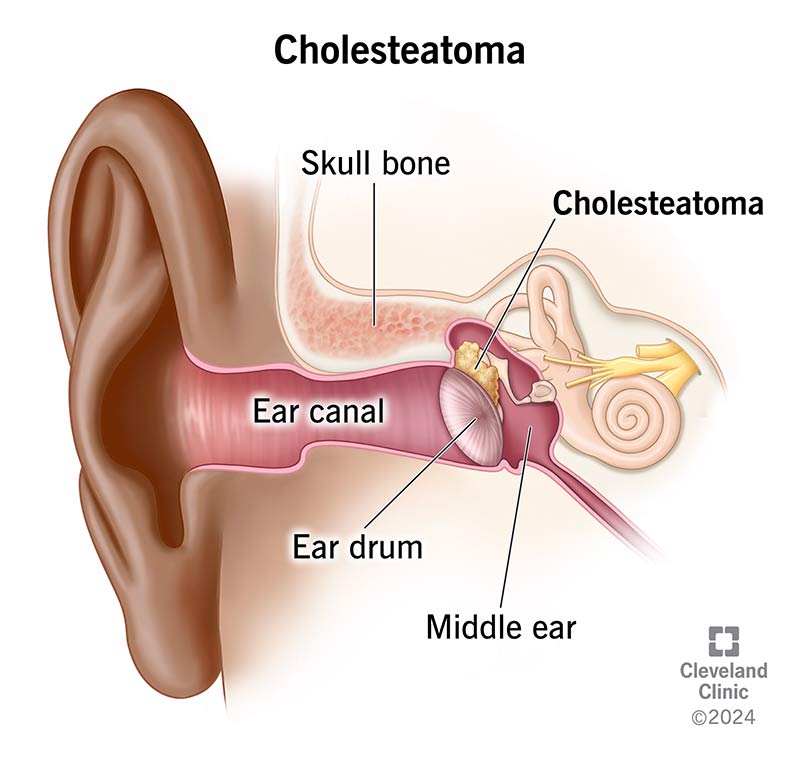Ear disease cholesteatoma-various-aspects-
A benign skin growth in the middle ear, known as a cholesteatoma, can cause severe harm if left untreated. It’s defined by a group of skin cells that have the ability to destroy nearby tissues and structures, such as the tiny bones in the middle ear. These cells are frequently located behind the eardrum or in the mastoid bone.
Cholesteatoma
An abnormal growth in your middle ear behind your eardrum is called a cholesteatoma. It may be inherited (present from birth), but it usually results from persistent ear infections. Although a foul discharge from the ear is the most frequent indication, the illness can also result in dizziness and hearing loss. The growth is treated by surgical excision.

What is a cholesteatoma?
A cholesteatoma is an abnormal growth located behind the tympanic membrane, also known as the eardrum. It arises when dead skin cells collect behind your eardrum, forming a lump or cyst that can resemble a pearl. A cholesteatoma might be present at birth, but it is more frequently caused by a ruptured eardrum or retracted eardrum.
If left untreated, cholesteatomas can become infected or get big enough to harm your hearing and facial nerve. The only way to treat a cholesteatoma is with surgical removal of the mass.
If any patient of ENT requires any surgery, opd consultation or online consultation in clinic of ENT specialist Doctor Dr Sagar Rajkuwar ,he may contact him at the following address-
Prabha ENT clinic, plot no 345,Saigram colony, opposite Indoline furniture Ambad link road, Ambad ,1 km from Pathardi phata Nashik ,422010, Maharashtra, India-Dr Sagar Rajkuwar (MS-ENT), Cell no- 7387590194 , 9892596635
Issued in public interest by –
Causes and Symptoms
What are the signs of a cholesteatoma?
The symptoms of a cholesteatoma depend on whether it is congenital (present at birth) or acquired (develops over time). A congenital cholesteatoma may not exhibit symptoms until it gets bigger. During a physical exam, your child’s pediatrician may discover a congenital cholesteatoma in their ear. The illness, whether inherited or acquired, can manifest in the following symptoms:


- a foul-smelling discharge that might resemble pus coming out of your or your child’s ear.
- The sensation of fullness or pressure in your ear.
- Dizziness.
- Recurring ear infections
- The illness can occasionally result in tinnitus or hearing loss.
What is the primary cause of a cholesteatoma?
A retracted eardrum is one of the primary reasons. An imbalance between the air inside and outside of your ear occurs during this period. As a result, your eardrum is drawn into your middle ear. When this occurs, you might get a cyst or pocket that becomes a cholesteatoma when it fills with skin cells.
Ruptured eardrums or chronic ear infections (acute otitis media) are other potential causes of cholesteatomas. The illness is uncommon at birth.
Diagnosis and Examinations
What methods are used to identify a cholesteatoma?
The healthcare professional will inquire about your symptoms and medical history, including any previous ear infections. Using an otoscope, which allows them to view your eardrum, they will inspect your ears.
You will be sent to an ear, nose, and throat expert (otolaryngologist) if they believe you may have a cholesteatoma. Your otolaryngologist can perform the following examinations:
- To determine whether the illness is hurting your ear bones (ossicles), a computed tomography (CT) scan is performed.
- Hearing exams, which include a tympanometry test.
Management and Treatment
What therapies are available for a cholesteatoma?
While the course of therapy is determined by the underlying etiology and symptoms, the only methods to get rid of a cholesteatoma are surgical procedures like mastoidectomy and tympanoplasty.
Prevention
Is it possible to prevent the development of cholesteatomas?
Although you can’t avoid having a congenital cholesteatoma, there are precautions you can take to lower your risk of getting one:
- Avoid prolonged infections or practices that might damage your eardrum.
- If you experience frequent ear infections, speak with a medical professional.
Outlook / Prognosis
If I have a cholesteatoma, what might I anticipate?
For the majority of individuals, surgery to remove a cholesteatoma will resolve their symptoms. However, cholesteatomas can recur. It’s possible that your otolaryngologist will advise you to schedule routine examinations. A checkup may include:
- Hearing and ear exams to look for evidence of new cholesteatoma.
- Ear washing (debridement) to get rid of the accumulation of skin cells and other tissue.
Living With
When should I schedule an appointment with my otolaryngologist?
If you experience any of the following symptoms following surgery, call your otolaryngologist:
- Blood or fluid leaking from your ear.
- Pain in the ear.
- a temperature of 104 degrees Fahrenheit (38 degrees Celsius).
If you experience symptoms such ear discharge, which might indicate the development of a new cholesteatoma, you should also see your otolaryngologist.





